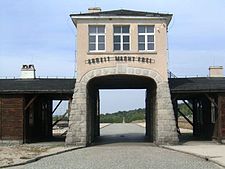
Back معسكر اعتقال جروس روزن Arabic Qross-Rozen həbs düşərgəsi Azerbaijani Gross-Rosen Catalan Koncentrační tábor Gross-Rosen Czech Gross-Rosen koncentrationslejr Danish KZ Groß-Rosen German Στρατόπεδο συγκέντρωσης Γκρος-Ρόζεν Greek Koncentrejo Gross-Rosen Esperanto Campo de concentración de Gross-Rosen Spanish اردوگاه کار اجباری گروسروزن Persian
| Gross-Rosen | |
|---|---|
| Nazi concentration camp | |
 Gross-Rosen entrance gate with the phrase Arbeit Macht Frei | |
| Other names | German: Konzentrationslager Groß-Rosen |
| Commandant |
|
| Operational | Summer of 1940 – 14 February 1945 |
| Inmates | mostly Jews, Poles and Soviet citizens[1] |
| Number of inmates | 125,000 (in estimated 100 subcamps) |
| Killed | 40,000 |
| Notable inmates | Boris Braun, Adam Dulęba, Franciszek Duszeńko, Heda Margolius Kovály, Władysław Ślebodziński, Simon Wiesenthal, Rabbi Shlomo Zev Zweigenhaft[2] |
Gross-Rosen was a network of Nazi concentration camps built and operated by Nazi Germany during World War II. The main camp was located in the German village of Gross-Rosen, now the modern-day Rogoźnica in Lower Silesian Voivodeship, Poland,[1] directly on the rail-line between the towns of Jawor (Jauer) and Strzegom (Striegau).[3][4] Its prisoners were mostly Jews, Poles and Soviet citizens.[1]
At its peak activity in 1944, the Gross-Rosen complex had up to 100 subcamps located in eastern Germany and in German-occupied Czechoslovakia and Poland. The population of all Gross-Rosen camps at that time accounted for 11% of the total number of inmates incarcerated in the Nazi concentration camp system.[1]
- ^ a b c d Cite error: The named reference
gross-rosen.euwas invoked but never defined (see the help page). - ^ Konieczny, Alfred. Arbeitslager Bunzlau I - podoboz KL Gross Rosen (2004 ed.). Muzeum Gross-Rosen. pp. 69, 75. ISBN 83-919919-8-9.
- ^ The Gross-Rosen Museum in Rogoźnica. Homepage.
- ^ Alfred Konieczny (pl), Encyclopaedia of the Holocaust. NY: Macmillan 1990, vol. 2, pp. 623–626.
© MMXXIII Rich X Search. We shall prevail. All rights reserved. Rich X Search